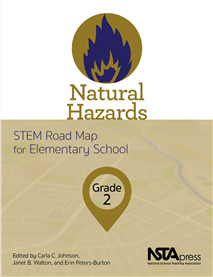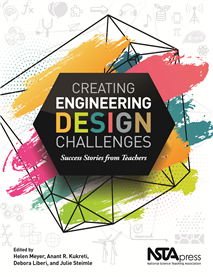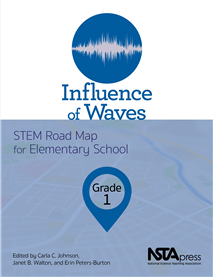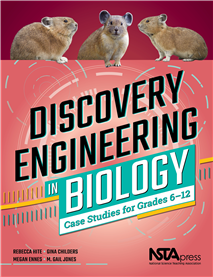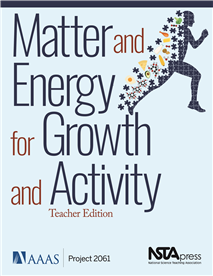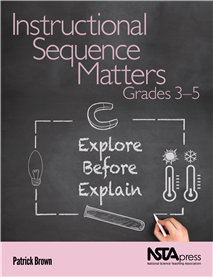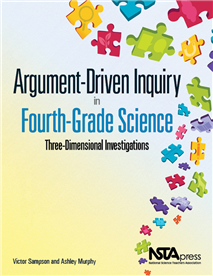All Book Chapters
Book Chapter
The American Association for the Advancement of Science (AAAS) is the largest general science organization in the world. Among the range of initiatives sponsored by AAAS is the Dialogue on Science, Ethics, and Religion (DoSER) program. However, in th...
Book Chapter
The Future of Science and Religion in American Schools
While it is not usually the first thing that science educators focus on in our communication with students, colleagues, or community members, the act of teaching is underpinned by a belief in, and hope for, a better future. While we do not necessaril...
Book Chapter
Leave It to Beavers: Should We Relocate the Beaver Dam?
In this lesson, suggested for grades K-2, students examine the manner in which beavers change their environment to survive by building dams and lodges. Students engage in an engineering design challenge in which they work together as a beaver family ...
Book Chapter
Swingy Thingy: What Makes a Great Playground?
In this lesson, suggested for grades K-2, students explore the way pushes and pulls affect the speed and direction of objects using both playground swings and model swings that they build and test. They experiment with swings on the playground and mo...
Book Chapter
Take a (Farm) Stand: Can Plants Help Us Fight Hunger?
In this lesson, suggested for grades K-2, students conduct a series of experiments on bean plants to determine what plants need to live and grow. They also compare and contrast individual bean plants to recognize the variation that can exist in obser...
Book Chapter
Monkey Business: Do We Need Zoos?
In this lesson, suggested for grades K-2, students take two virtual visits to a zoo—one by reading a book and the other by conducting online research. Students are asked to use their observational skills to spot the ways that parents and offspring ...
Book Chapter
Soaky, Doaky: What’s the Best Way to Clean Up Spills?
Is Bounty really the “quicker picker upper”? In this lesson, suggested for grades K-2, students have the opportunity to test advertisers’ claims through laboratory investigations. This lesson focuses on the two main properties of paper towels�...
Book Chapter
Bee-ing There for Bees: Are Bees Disappearing?
In this lesson, suggested for grades K-2, students learn about bee anatomy and behavior. They develop and test bee models to demonstrate their understanding of the interrelationships between plants and pollinators. After examining some of the controv...
Book Chapter
Weather or Not? Should We Rebuild in Twisterville?
In this lesson, suggested for grades K-3, students are introduced to tornadoes through a picture book. They make observations using water-filled bottles that function as “Tornadoes in a Bottle” when they create a swirling motion and evaluate the ...
Book Chapter
Eggstreme Sports: Is Football Too Dangerous for Kids?
In this lesson, suggested for grades 3-5, students learn about brain anatomy to reinforce the idea that the brain is an internal structure that has a specific role in the body’s functioning. They then create and test helmets undergoing impact, usin...
Book Chapter
Marsh Madness: What’s Your Plan for the Bullfrog Pond?
In this lesson, suggested for grades 3-5, students investigate the ecological relationships between living and nonliving components of a wetland and collaboratively determine the type, extent, and consequences of nearby development. They learn about ...
Book Chapter
Finders Keepers?: Who Owns the Dinosaur Bones?
In this lesson, suggested for grades 3-5, students learn how fossils provide clues about Earth’s past. After being introduced to the concept of fossils, they examine various objects to determine whether they are fossils. They then engage in a fossi...
Book Chapter
Blast From the Past: Do We Still Need a Space Program?
In this lesson, suggested for grades 3-5, the flight of Apollo 11 serves as a context for learning about forces and motion as students explore rocket launches and parachute landings. They then examine the scientific, economic, political, and philosop...
Book Chapter
“Mined” Your Own Business: Was the California Gold Rush Good for the United States?
In this lesson, suggested for grades 3-5, students simulate panning for gold within the context of the California gold rush to examine the properties of pyrite, or fool’s gold, and compare them with the properties of real gold. Additionally, they a...
Book Chapter
Fueling Around: Which Energy Sources Are Best?
In this lesson, suggested for grades 3-5, students begin an exploration of energy by reading the true story of a Danish island that became completely energy independent, relying only on renewable energy sources including wind, solar, and biomass. The...
Book Chapter
Watch Your Step: Should Distracted Walking Be Illegal?
In this lesson, suggested for grades 3-5, students are introduced to the problem of “distracted walking,” which occurs when people use their phones for calling, texting, or taking photos. They are introduced to the problem through videos of news ...
Book Chapter
Natural Hazards, Grade 2: STEM Road Map for Elementary School (Book Sample)
What if you could challenge your second graders to help communities prepare for disasters ranging from floods and wildfires to earthquakes and hurricanes? With this volume in the STEM Road Map Curriculum Series, you can!...
Book Chapter
Students explore natural hazards and their causes, with the aim of understanding that various types of natural hazards occur around the world. These hazards can be classified as those with weather-related causes and those caused by movements within E...
Book Chapter
In this lesson, students continue to explore natural hazards and connect the impacts with effects on animals’ homes. They investigate earthquakes as an example of a natural hazard caused by phenomena within Earth. Working in teams, they use the eng...
Book Chapter
Our Natural Hazard Preparedness Plans
In this lesson, students work in teams to demonstrate their understanding of the impacts of natural hazards by creating preparedness plans describing how people and communities can prepare. Student teams also create public service announcements (PSAs...
Book Chapter
Creating Engineering Design Challenges: Success Stories From Teachers (Book Sample)
If you’ve ever wished for advice you can trust on how to make science and math more relevant to your middle or high school students, Creating Engineering Design Challenges is the book for you. At its core are 13 units grounded in challenge-based le...
Book Chapter
Influence of Waves, Grade 1: STEM Road Map for Elementary School (Book Sample)
Available for Pre-order. This product will be released in OCTOBER 2019What if you could challenge your first graders to create instruments they can play in their own “Show Me the Waves” musical show? With this volume in the STEM Road Map Curric...
Book Chapter
Discovery Engineering in Biology: Case Studies for Grades 6–12 (Book Sample)
Show your students how amazing it can be to just “see what will happen” when they blend biology, engineering, and serendipity. Focusing on innovations sparked by accidental or unexpected observations, the case studies in this resource are a livel...
Book Chapter
It’s Still Debatable! Using Socioscientific Issues to Develop Scientific Literacy, K–5 (Book Sample)
It’s Still Debatable! encourages scientific literacy by showing you how to teach the content and thinking skills K–5 students need to explore real-world questions like these: • Is football too dangerous for kids? • Do we need zoos? �...
Book Chapter
Making Sense of Science and Religion: Strategies for the Classroom and Beyond (Book Sample)
“I have been hoping for a volume like this for a long time. Making Sense of Science and Religion marshals the best scholarship on science and religion toward the deeply practical aim of helping science teachers understand what is at stake for both ...
Book Chapter
Matter and Energy for Growth and Activity, Teacher Edition (Book Sample)
How do our bodies manage to heal wounds, build the stamina to run marathons, and give us the energy—even while we’re sleeping—to keep us alive and functioning? Matter and Energy for Growth and Activity prompts high school students to explore fa...
Book Chapter
Instructional Sequence Matters, Grades 3–5: Explore Before Explain (Book Sample)
Instructional Sequence Matters, Grades 3–5 is a one-stop resource that will inspire you to reimagine how you teach science in elementary school. The book discusses two popular approaches for structuring your lessons: POE (Predict, Observe, and Expl...
Book Chapter
The guiding question of this investigation is, How does changing the speed of a marble affect the energy of that marble? In this lesson, students will need to figure out how changing the speed of a moving marble (a cause) affects the energy that the...
Book Chapter
Energy Transfer Through Collisions
The guiding question of this investigation is, How does the energy of a moving ball change after it collides with objects that have different masses? In this lesson, the goal is to figure out how the energy of a moving billiard ball will change whe...
Book Chapter
Energy Transfer Between Liquids
The guiding question of this investigation is, How can we predict how much the temperature of 100 ml of water will change when we add different amounts of hot water to it? In this lesson, the goal is to figure out a way to predict how much the temp...
Book Chapter
The guiding question of this investigation is, How does the distance between a light source and an object affect the amount of energy an object receives from the light source? In this lesson, the goal is to figure out how the amount of energy an obj...
Book Chapter
The guiding question of this investigation is, How does adding more batteries or bulbs to a closed circuit affect the brightness of a single bulb within that circuit? In this lesson, the goal is to figure out how the addition of more batteries and ...
Book Chapter
Energy Transfer by Electric Currents
The guiding question of this investigation is, How can we make an electric car move faster? In this lesson, students will apply what they know about electric currents, closed circuits, and the transfer of energy to create an electric car. Then figu...
Book Chapter
The guiding question of this investigation is, How does changing the mass of an object that is dropped into water affect the height of the resulting wave and the position of a floating toy boat? In this lesson, the goal is to figure out how the mas...
Book Chapter
Characteristics of Sound Waves
The guiding question of this investigation is, How can we use the properties of waves to explain different sounds? Sound waves are created when a disturbance travels through a substance or material from one place to another. In this lesson, student...
Book Chapter
The guiding question of this investigation is, What is the relationship between the location of an object and the location of its image in a mirror? In this lesson, the goal is to figure out how to predict where an image of a pencil in a mirror wil...
Book Chapter
Patterns and the Transfer of Information
The guiding question of this investigation is, How can we use an electric circuit to accurately transfer information about the content of a picture? To accomplish the goal In this lesson, students will use what they know about electric currents and...
Book Chapter
The guiding question of this investigation is, How does water move from the roots to the leaves of a plant? In this lesson, the goal is to figure out how water moves into, within, and out of a plant while traveling from the roots to its leaves. To a...
Book Chapter
The guiding question of this investigation is, How should we classify the unknown organisms? In this lesson, the goal is to figure out how to classify an unknown animal based on the type of food it eats and how the structure of an animal’s skull ...
Book Chapter
The guiding question of this investigation is, What type of environmental conditions do mealworms seek out? In this lesson, the goal is to figure out the types, as well as how mealworms respond to the different types of environmental conditions the...





